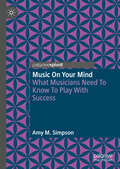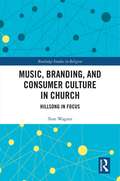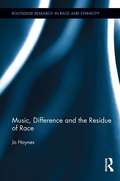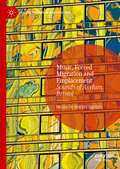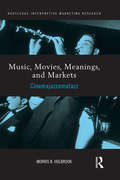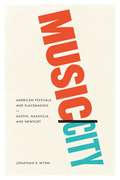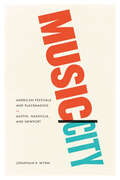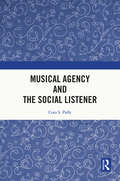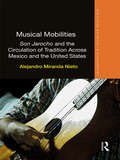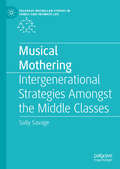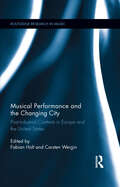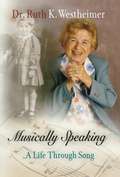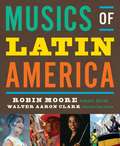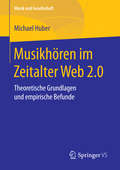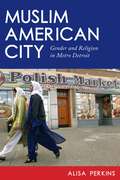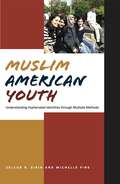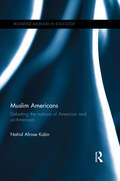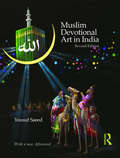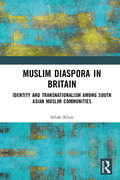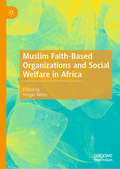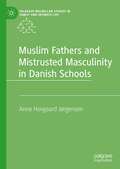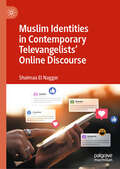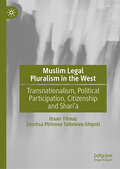- Table View
- List View
Music on Your Mind: What Musicians Need to Know to Play with Success
by Amy M. SimpsonThis book provides musicians, students, and teachers a practical guide for optimal music learning, practice, memorization, and performance by the application of modern neuro-music research. Uncover the best, scientifically researched techniques, supported by researchers and musicians alike, that will empower you to learn thoroughly, practice optimally, and perform at your best. Do you know how people learn? Do you know how people improve motor-skills for playing an instrument? Do you know how to focus attention and stay motivated? Discover the essential answers you need to revitalize and optimize your daily work as a musician. By applying the best methods and knowing why they work, you, too, can create successful practice routines with positive, rewarding, results. Know the best techniques for preparing expert music performance. Learn how to play with success!
Music, Branding and Consumer Culture in Church: Hillsong in Focus (Routledge Studies in Religion)
by Tom WagnerStarting as a single congregation in Australia, Hillsong Church now has campuses worldwide, releases worship music that sells millions of albums and its ministers regularly appear in mainstream media. So, how has a single church gained such international prominence? This book offers an ethnographic exploration of the ways in which music and marketing have been utilised in the pursuit and production of spiritual experience for members of Hillsong Church. An experience that has proven to be incredibly popular. The main theme of this book is that marketing, specifically branding, is not just a way to "sell" religion, but rather an integral part of spiritual experience in consumer society. Focussing on the London Hillsong church as a case study, the use of its own music in tandem with strong branding is shown to be a co- and re-productive method of organizing, patterning, and communicating information. The church provides the branded material and cultural context in which participants’ sacred experience of self unfolds. However, this requires participants to "do the work" to properly understand, and ultimately embody, the values associated with the brand. This book raises important questions about the role of branding and music in forming modern scared identities. As such, it will be of great interest to scholars of Religious Studies, Ethnomusicology and Media Studies.
Music, Difference and the Residue of Race (Routledge Research in Race and Ethnicity #5)
by Jo HaynesRace and music seem fatally entwined in a way that involves both creative ethnic hybridity and ongoing problems of racism. This book presents a sociological analysis of this enduring relationship and asks: how are ideas of race critical to the understanding of music genres and preferences? What does the 'love of difference' via music contribute to contemporary perspectives of racism? Previous studies of world music have situated it within the dynamics of local/global musical production, the representation of nations and ethnic groups, theories of globalization, hybridization and cultural appropriation. Haynes adds a conceptual and textual shift to these debates by utilizing world music as a lens for examining cultural imaginaries of race and analytical nuances of racialization. The text offers a view of world music from 'within,' building on original, qualitative, interview-based research with people from the British world music scene. These interviews provide unique insights into the discursive repertoires that underpin contemporary culture, and will make a significant contribution to the mainly theoretical debates about world music.
Music, Forced Migration and Emplacement: Sounds of Asylum Bristol (Leisure Studies in a Global Era)
by Nicola De Martini UgolottiThis book analyses the negotiation of place, belonging and uncertainty enacted by a group of 60 men and women seeking asylum who gathered weekly in a community space in Bristol, UK, to share songs, memories, laughter, and precariousness with other established and new city-dwellers. Building on a rich corpus of ethnographic data, this book explores music-making to address “what goes unnoticed” in existing ways of thinking about forced migration. By looking at the junctures where leisure, forced migration and urban analyses intersect with grassroot solidarity with and by people seeking asylum, it offers an interdisciplinary reading of music, forced migration and emplacement for scholars across leisure, anthropology, sociology, and geography. This book contributes and provokes novel discussions regarding refugees’ everyday experiences and negotiations of precariousness, suspension, and marginality in Britain.
Music, Movies, Meanings, and Markets: Cinemajazzamatazz (Routledge Interpretive Marketing Research)
by Morris HolbrookMusic, Movies, Meanings, and Markets focuses on macromarketing-related aspects of film music in general and on the cinemusical role of ambi-diegetic jazz in particular. The book examines other work on music in motion pictures which has dealt primarily with the traditional distinction between nondiegetic film music (background music that comes from off-screen and is not audible to the film’s characters, to further the dramatic development of plot, character, or other themes) and diegetic music (source music produced on-screen and/or that is audible to the film’s characters, adding to the realism of the mise-en-scène without contributing much to other dramatic meanings). This book defines, describes, and illustrates another hitherto-neglected type of film music –ambi-diegetic film music, which appears on-screen but which contributes to the dramatic development of plot, character, and other themes. Consistent with an interest in macromarketing, such ambi-diegetic film music serves as a kind of product placement (suitable for commercialization via the cross-promotion of soundtrack albums, for example) and plays a role in product design. It also provides one type of symbolic consumer behavior that indicates choices made by film characters when playing-singing-listening-or-dancing in ways that reveal their personalities or convey other cinemusical meanings. Morris Holbrook argues that ambi-diegetic film music sheds light on various social issues –such as the age-old tension between art and entertainment as it applies to the contrast between creative integrity and commercialization. Music, Movies, Meanings, and Markets explores the ways in which ambi-diegetic jazz contributes to the development of dramatic meanings in various films, many of which address the art-versus-commerce theme as a central concern.
Music/City
by Jonathan R. WynnAustin's famed South by Southwest is far more than a festival celebrating indie music. It's also a big networking party that sparks the imagination of hip, creative types and galvanizes countless pilgrimages to the city. Festivals like SXSW are a lot of fun, but for city halls, media corporations, cultural institutions, and community groups, they're also a vital part of a complex growth strategy. In Music/City, Jonathan R. Wynn immerses us in the world of festivals, giving readers a unique perspective on contemporary urban and cultural life. Wynn tracks the history of festivals in Newport, Nashville, and Austin, taking readers on-site to consider different festival agendas and styles of organization. It's all here: from the musician looking to build her career to the mayor who wants to exploit a local cultural scene, from a resident's frustration over corporate branding of his city to the music executive hoping to sell records. Music/City offers a sharp perspective on cities and cultural institutions in action and analyzes how governments mobilize massive organizational resources to become promotional machines. Wynn's analysis culminates with an impassioned argument for temporary events, claiming that when done right, temporary occasions like festivals can serve as responsive, flexible, and adaptable products attuned to local places and communities.
Music/City: American Festivals and Placemaking in Austin, Nashville, and Newport
by Jonathan R. WynnAustin’s famed South by Southwest is far more than a festival celebrating indie music. It’s also a big networking party that sparks the imagination of hip, creative types and galvanizes countless pilgrimages to the city. Festivals like SXSW are a lot of fun, but for city halls, media corporations, cultural institutions, and community groups, they’re also a vital part of a complex growth strategy. In Music/City, Jonathan R. Wynn immerses us in the world of festivals, giving readers a unique perspective on contemporary urban and cultural life. Wynn tracks the history of festivals in Newport, Nashville, and Austin, taking readers on-site to consider different festival agendas and styles of organization. It’s all here: from the musician looking to build her career to the mayor who wants to exploit a local cultural scene, from a resident’s frustration over corporate branding of his city to the music executive hoping to sell records. Music/City offers a sharp perspective on cities and cultural institutions in action and analyzes how governments mobilize massive organizational resources to become promotional machines. Wynn’s analysis culminates with an impassioned argument for temporary events, claiming that when done right, temporary occasions like festivals can serve as responsive, flexible, and adaptable products attuned to local places and communities.
Musical Agency and the Social Listener
by Cora S. PalfyMusic as a narrative drama is an intriguing idea, which has captured explicit music theoretical attention since the nineteenth century. Investigations into narrative characters or personae has evolved into a sub-field—musical agency. In this book, Palfy contends that music has the potential to engage us in social processes and that those processes can be experienced as a social interaction with a musical agent. She explores the overlap between the psychological processes in which we participate in order to understand and engage with people, and those we engage in when we listen to music. Thinking of musical agency as a form of social process is quite different from existing theoretical frameworks for agency. It implies that we come to musical analysis by way of intuition—that our ideas are already partially formed based on our experience of the piece (and what it makes us feel or how it makes us sense it as any other) when we choose to analyze and interpret it. Palfy’s focus on social processes is a very effective way to pinpoint when and why it is that our attention is captured and engaged by musical agents.
Musical Mobilities: Son Jarocho and the Circulation of Tradition Across Mexico and the United States (Routledge Advances in Ethnography)
by Alejandro Miranda NietoHow do musical practices move? Though technology increasingly plays a great part in establishing different degrees of spatial proximity, music making still seems to be tied to specific geographical locations, cultures or communities. The identity of musical traditions, in particular, is often demarcated by a presumed degree of uniformity amongst its practitioners. Musical Mobilities analyses how a musical tradition moves literally and metaphorically: the ways in which people, objects and information travel across geographical locations, just as practices as recognisable entities circulate along with meanings, competencies and embodied dispositions. This unique ethnography focuses on son jarocho, a musical practice originating in southeast Mexico that is currently reproduced through transnational connections, particularly in the United States. Paradoxically, the transformation of son jarocho has been a noticeable outcome of its recuperation and preservation. Thus, in describing the moves of this musical tradition, this book provides a theoretical and empirical perspective on the dissonances between cultural continuity and change. The first ethnographic work to explicitly address the continuity and transformation of a musical practice through the analysis of multiple forms of mobility and fixity, Musical Mobilities will appeal to undergraduate and postgraduate students and postdoctoral researchers interested in fields such as Latin American & Hispanic Studies, South American Music, Ethnomusicology, Cultural Studies and Sociology of Culture.
Musical Mothering: Intergenerational Strategies Amongst the Middle Classes (Palgrave Macmillan Studies in Family and Intimate Life)
by Sally SavageThis book examines how gender and class discourses shape 'musical mothering' by incorporating knowledges from sociology, psychology, cultural studies, and education. Chapters detail the fundamental and functional role that mothers play in children's musical development alongside children's agency in influencing familial experiences. Music plays an essential role in the lives of mothers for themselves. Through interviews with mothers and grandmothers, as well as the author's own autobiographical reflections, the author offers a unique interdisciplinary approach to motherhood and music within Australian culture.
Musical Performance and the Changing City: Post-industrial Contexts in Europe and the United States (Routledge Research in Music)
by Fabian Holt Carsten WerginA contribution to the field of urban music studies, this book presents new interdisciplinary approaches to the study of music in urban social life. It takes musical performance as its key focus, exploring how and why different kinds of performance are evolving in contemporary cities in the interaction among social groups, commercial entrepreneurs, and institutions. From conventional concerts in rock clubs to new genres such as the flash mob, the forms and meanings of musical performance are deeply affected by urban social change and at the same time respond to the changing conditions. Music has taken on complex roles in the post-industrial city where culture and cultural consumption have an unprecedented power in defining publics, policies, and marketing strategies. Further, changes in real estate markets and the penetration of new media have challenged even fairly modern music cultures. At the same time, new music cultures have emerged, and music has become a driver for cultural events and festivals, channeling the dynamics of a society characterized by the social change, media intensity, and the neoliberal forces of post-industrial urban contexts. The volume brings together scholars from a broad range of disciplines to build a shared understanding of post-industrial contexts in Europe and the United States. Most directly grounded in contemporary developments in music studies and urban studies, its broad interdisciplinary range serves to strengthen the relevance of urban music studies to fields such as anthropology, sociology, urban geography, and beyond. Offering in-depth studies of changing music culture in concert venues, cultural events, and neighborhoods, contributors visit diverse locations such as Barcelona, Berlin, London, New York, and Austin.
Musically Speaking
by Dr Ruth K. Westheimer"Music, I have come to realize, is for me a kind of golden thread running through my life. It has helped maintain my connection with the past that otherwise might have been severed by catastrophe and time. I am often asked--indeed, I often wonder myself--why it is that I should always have had such joie de vivre in the face of the losses and dislocations I had to endure in my early years. The answer I always gave was that the warmth and security of my early childhood had a remarkable power and influence. This is certainly true. But now I have realized that there is another part to the answer. And that is music."--from the introductionWho among us does not have a song that triggers vivid memories--of jubilation, of belonging, of sorrow, of love? In Musically Speaking, Dr. Ruth K. Westheimer, one of America's most beloved personalities, has written a warm and contemplative book about the role music has played in her life and the ineradicable traces it has left on her thoughts, emotions, her very being.In this memoir through song, Dr. Ruth invites us to share her story from a uniquely musical perspective. By the time she was thirty, Ruth Westheimer had lived in five countries, each with a distinctive musical culture, each with a different hold on her sensibility. For the first ten years of her life, the comforting melodies of childhood helped drown out the anthems of Nazism to be heard elsewhere in her native Germany; as an adolescent refugee in Switzerland, she came to be aware that, however loudly she sang the patriotic songs of the land that gave her shelter, she could never truly be at home there.Present at the creation of the modern state of Israel, she sang and danced to the new music of a new nation; as a young woman eagerly absorbing all that Paris had to offer in the way of romance and worldliness in the early 1950s, the songs of Edith Piaf, Mouloudji, and Yves Montand were her tutors. An almost accidental emigration to America brought new challenges and new stability, as she became a wife, mother, and professional; tremendous and unforeseen celebrity came later, and with it the giddy opportunity to indulge her love of music as never before.Always, the classical repertoire of Mozart, Haydn, Beethoven, and Brahms has drawn Westheimer to a German culture that has belonged--and not belonged--to her throughout her life. And always, the music of the Jewish tradition has given her strength and comfort beyond words.Affording a view of Dr. Ruth from a rare private vantage point, Musically Speaking offers wondrous testimony to the resilience of the human spirit. This is a book full of color, verve, humor, and wisdom, unfolding gracefully through the beloved music of the Jewish holidays, the lullabies of childhood, the songs that sustained an orphan and roused the courage of a young woman, the melodies that enable a widow grieving for her husband to recall, from deep within the years of love, companionship, and happiness.
Musics of Latin America
by Robin Moore Walter Aaaron Clark Deborah Schwartz-Kates John Koegel Cristina Magaldi Daniel Party Jonathan Ritter T. M. Scruggs Susan ThomasCovering one of the most musically diverse regions in the world, Musics of Latin America emphasizes music as a means of understanding culture and society: each author balances an analysis of musical genres with discussion of the historical and cultural trends that have shaped them. Chapters cover traditional, popular, and classical repertoire, and in-text listening guides ensure that students walk away with a solid understanding of the music.
Musikhören im Zeitalter Web 2.0
by Michael HuberIn Anschluss an aktuelle Erkenntnisse soziologischer und sozialpsychologischer Musikrezeptionsforschung erläutert der Band, welche gesellschaftlichen Funktionen das Musikhören heute erfüllt und welche Rolle hier die neuen Rahmenbedingungen im Web 2.0 spielen. Auf Basis repräsentativer empirischer Erhebungen werden musikalische Einstellungen und Verhaltensweisen illustriert sowie klar abgrenzbare Musikhörtypen charakterisiert, die in je besonderer Weise mit den aktuellen Möglichkeiten und Herausforderungen der digitalen Mediamorphose umgehen. Besondere Berücksichtigung findet dabei die Frage nach der Bedeutung primärer Sozialisation als Gegengewicht zur musikalischen Selbstsozialisation im Internet. Vor allem Alter, Schulbildung und Wohnortsgröße der Menschen zeigen sich als entscheidende Einflussgrößen der individuellen musikalischen Praxis in Österreich.
Muslim American City: Gender and Religion in Metro Detroit
by Dr. Alisa PerkinsExplores how Muslim Americans test the boundaries of American pluralismIn 2004, the al-Islah Islamic Center in Hamtramck, Michigan, set off a contentious controversy when it requested permission to use loudspeakers to broadcast the adhān, or Islamic call to prayer. The issue gained international notoriety when media outlets from around the world flocked to the city to report on what had become a civil battle between religious tolerance and Islamophobic sentiment. The Hamtramck council voted unanimously to allow mosques to broadcast the adhān, making it one of the few US cities to officially permit it through specific legislation.Muslim American City explores how debates over Muslim Americans’ use of both public and political space have challenged and ultimately reshaped the boundaries of urban belonging. Drawing on more than ten years of ethnographic research in Hamtramck, which boasts one of the largest concentrations of Muslim residents of any American city, Alisa Perkins shows how the Muslim American population has grown and asserted itself in public life. She explores, for example, the efforts of Muslim American women to maintain gender norms in neighborhoods, mosques, and schools, as well as Muslim Americans’ efforts to organize public responses to municipal initiatives. Her in-depth fieldwork incorporates the perspectives of both Muslims and non-Muslims, including Polish Catholics, African American Protestants, and other city residents. Drawing particular attention to Muslim American expressions of religious and cultural identity in civil life—particularly in response to discrimination and stereotyping—Perkins questions the popular assumption that the religiosity of Muslim minorities hinders their capacity for full citizenship in secular societies. She shows how Muslims and non-Muslims have, through their negotiations over the issues over the use of space, together invested Muslim practice with new forms of social capital and challenged nationalist and secularist notions of belonging.
Muslim American Youth: Understanding Hyphenated Identities through Multiple Methods (Qualitative Studies in Psychology #12)
by Michelle Fine Selcuk R. SirinSince the terrorist attacks of September 11, 2001, and the subsequent “war on terror,” growing up Muslim in the U.S. has become a far more challenging task for young people. They must contend with popular cultural representations of Muslim-men-as-terrorists and Muslim-women-as-oppressed, the suspicious gaze of peers, teachers, and strangers, and police, and the fierce embodiment of fears in their homes.With great attention to quantitative and qualitative detail, the authors provide heartbreaking and funny stories of discrimination and resistance, delivering hard to ignore statistical evidence of moral exclusion for young people whose lives have been situated on the intimate fault lines of global conflict, and who carry international crises in their backpacks and in their souls.The volume offers a critical conceptual framework to aid in understanding Muslim American identity formation processes, a framework which can also be applied to other groups of marginalized and immigrant youth. In addition, through their innovative data analytic methods that creatively mix youth drawings, intensive individual interviews, focused group discussions, and culturally sensitive survey items, the authors provide an antidote to “qualitative vs. quantitative” arguments that have unnecessarily captured much time and energy in psychology and other behavioral sciences.Muslim American Youth provides a much-needed road map for those seeking to understand how Muslim youth and other groups of immigrant youth negotiate their identities as Americans.
Muslim Americans: Debating the notions of American and un-American (Routledge Advances in Sociology)
by Nahid Afrose KabirWith Islamophobia on the rise in the US since 9/11, Muslims remain the most misunderstood people in American society. Taking as its point of departure the question of the compatibility of Islam and democracy, this book examines Muslims’ sense of belonging in American society. Based on extensive interview data across seven states in the US, the author explores the question of what it means to be American or un-American amongst Muslims, offering insights into common views of community, culture, and wider society. Through a combination of interviewees’ responses and discourse analysis of print media, Muslim Americans also raises the question of whether media coverage of the issue might itself be considered ‘un-American’. An empirically grounded study of race and faith-based relations, this book undertakes a rigorous questioning of what it means to be American in the contemporary US. As such, it will appeal to scholars of sociology and political science with interests in race, ethnicity, religion and national identity.
Muslim Backward Classes
by Azra KhanamThis book presents the sociological perspectives on Muslim OBCs as a category determined by the Indian State. Although Muslims constitute an important part of the population and are the second largest religious community in the world, as well as in India, social scientists rarely undertake this community to analyze their socioeconomic and educational development. Muslim Backward Classes provides a comprehensive explanation of the origin and meaning of the term "backward class," followed with the historical perspectives of Muslim backwardness in India. The volume fills the gap in the literature and presents a broad-based picture of the problems of Muslim OBCs, highlighting the questions of justice and equal opportunity to all groups irrespective of religion.
Muslim Belonging in Secular India
by Taylor C. ShermanMuslim Belonging in Secular India surveys the experience of some of India's most prominent Muslim communities in the early postcolonial period. Muslims who remained in India after the Partition of 1947 faced distrust and discrimination, and were consequently compelled to seek new ways of defining their relationship with fellow citizens of India and its governments. Using the forcible integration of the princely state of Hyderabad in 1948 as a case study, Taylor C. Sherman reveals the fragile and contested nature of Muslim belonging in the decade that followed independence. In this context, she demonstrates how Muslim claims to citizenship in Hyderabad contributed to intense debates over the nature of democracy and secularism in independent India. Drawing on detailed new archival research, Dr Sherman provides a thorough and compelling examination of the early governmental policies and popular strategies that have helped to shape the history of Muslims in India since 1947.
Muslim Devotional Art in India
by Yousuf SaeedThis book highlights the history of Islamic popular devotional art and visual culture in 20th-century India, weaving the personal narrative of the author’s journey through his understanding of the faith. It begins with an introductory exploration of how the basic and universal image of Mecca and Medina may have been imported into Indian popular print culture and what variants it resulted in here. Besides providing a historical context of the pre-print culture of popular Muslim visuality, the book also explores the impact the 1947 Partition of India may have made on the calendar art in South Asia. A significant portion of the book focuses on the contemporary prints of different localised images found in India and what role these play in the users’ lives, especially in the augmentation of their popular faith and cultural practices. The volume also compares the images published in India with some of those available in Pakistan to reflect different socio-political trajectories. Finally, it discusses why such a vibrant visual culture continues to thrive among South Asian Muslims despite the questions raised by the orthodoxy on its legitimacy in Islam, and why images and popular visual cultures are inevitable for popular piety despite the orthodox Muslims’ increasing dissociation from them. This work is one of the first books on Indian Muslim poster art, with rare images and simple narratives, anecdotes about rituals, ceremonies and cultural traditions running parallel to research findings. This second edition contains a new Afterword that discusses challenges to religious plurality arising on account of changing political landscapes, economic liberalisation, technology and new media, and socio-religious developments. It will appeal to the lay reader as well as the specialist and will be especially useful to researchers and scholars in popular culture, media and cultural studies, visual art and performance studies, and sociology and social anthropology.
Muslim Diaspora in Britain: Identity and Transnationalism among South Asian Muslim Communities
by Sabah KhanThis book explores the idea of Muslim diaspora in context of Muslim communities in the United Kingdom. It critically looks at the notion of ummah and presents a comprehensive account of South Asian Muslims in London. Employing qualitative research methods and drawing on extensive fieldwork, it delves into the identification and transnational connections of Muslims in Britain. It shows the ways in which religious identity, practices and experiences may instigate diasporas focusing on South Asian Muslims in London — Indian, Pakistani and Bangladeshi Muslims — who account for 3.6 per cent of the total population. Further, the inter as well as intra group dynamics and studies how Muslims of different ethnic background settled in the same geo-political context engage with the notion of ummah. The volume will be of great interest to scholars and researchers of religion, especially Islam, politics, British studies and South Asian studies.
Muslim Faith-Based Organizations and Social Welfare in Africa
by Holger WeissThis book addresses the discourses, agendas and actions of Muslim faith-based organizations and activists to empower Muslim communities in contemporary sub-Saharan Africa. The individual chapters discuss how traditional Muslim welfare and charity institutions, zakat (obligatory or mandatory almsgiving), sadaqa (voluntary almsgiving and donations) and waqf (pious endowments), are used to improve social welfare, focusing on instrumentalization and institutionalization in the collection and distribution of zakat. The book includes case studies from West Africa (Ghana, Burkina Faso, Cote d’Ivoire, Ghana and Senegal), the Horn of Africa (Somalia) and East Africa (Kenya and Tanzania), highlighting the role and interplay of local, national and international Sunni, Shia and Ahmadiyya Muslim faith-based organizations and NGOs. Chapters "Muslim NGOs, Zakat and the Provision of Social Welfare in Sub-Saharan Africa: An Introduction" and "Discourses on Zakat and Its Implementation in Contemporary Ghana" are available open access under a Creative Commons Attribution 4.0 International License via link.springer.com.
Muslim Fathers and Mistrusted Masculinity in Danish Schools (Palgrave Macmillan Studies in Family and Intimate Life)
by Anne Hovgaard JørgensenThis book seeks to provide a deeper understanding of Muslim migrant fathers’ experiences of home-school cooperation in Danish schools by identifying and contradicting a phenomenon of “mistrusted masculinity.” This term refers to a negative stereotype of Muslim migrant men that figures in political and media rhetoric where they are portrayed as controlling and patriarchal. Throughout the ethnography, migrant fathers confront this stereotype and express how they must navigate around this negative image in their struggle to be acknowledged as good fathers by their children’s schools. Jørgensen uses Geertzian “thick description” of micro-interaction between fathers and Danish teachers to explore the complex interplay of often-untested assumptions, misunderstandings, and untoward effects.
Muslim Identities in Contemporary Televangelists' Online Discourse
by Shaimaa El NaggarThis book examines the discourse of Muslim televangelism in the West, particularly looking at the emergence of 'home-grown' televangelists who grew up in the West and deliver their sermons in English, addressing audiences in contexts such as the UK and the USA. In their sermons, televangelists address topics that are relevant to the everyday life of Muslims and Muslim youth such as friendship, marriage and the misrepresentation of Islam/Muslims in mass media. This book explores contemporary Muslim televangelism and its manifestations in other forms of digital religion, including YouTube, websites and social media which mediate religious content. Using a Critical Discourse Studies approach, the author explores the power structures underpinning the popularity of Muslim televangelism, investigates the linguistic strategies used by Muslim televangelists to construct their identities online, and analyses how Islam and Muslims are represented in their sermons. This book will be of interest to religious studies, media studies, and discourse studies scholars, and to anyone interested in the topic of Islam/Muslims in the West in the contemporary age.
Muslim Legal Pluralism in the West: Transnationalism, Political Participation, Citizenship and Shari’a
by Ihsan Yilmaz Denitsa Pirinova Sokolova-ShipoliThis book is a comprehensive introductory text to the subject of Western Muslims’ diverse interpretations, discussions and practices of Shari’a with a particular focus on their daily lives in the West. Through a series of interconnected chapters, the book navigates key themes such as Shari’a and legal pluralism, Shari’a vis-à-vis the experiences and political participation of Muslims in Western democracies, the role of religious scholars, the dynamics of Shari’a courts, Shari’a and multiple belongings, and transnational loyalties. Functioning as a comprehensive reader and handbook, the book offers non-experts a comprehensive understanding of the meaning and relevance of Shari’a in Western contexts, exploring how Muslims interpret and apply its principles in their lived experiences and challenging the one-dimensional narratives.
